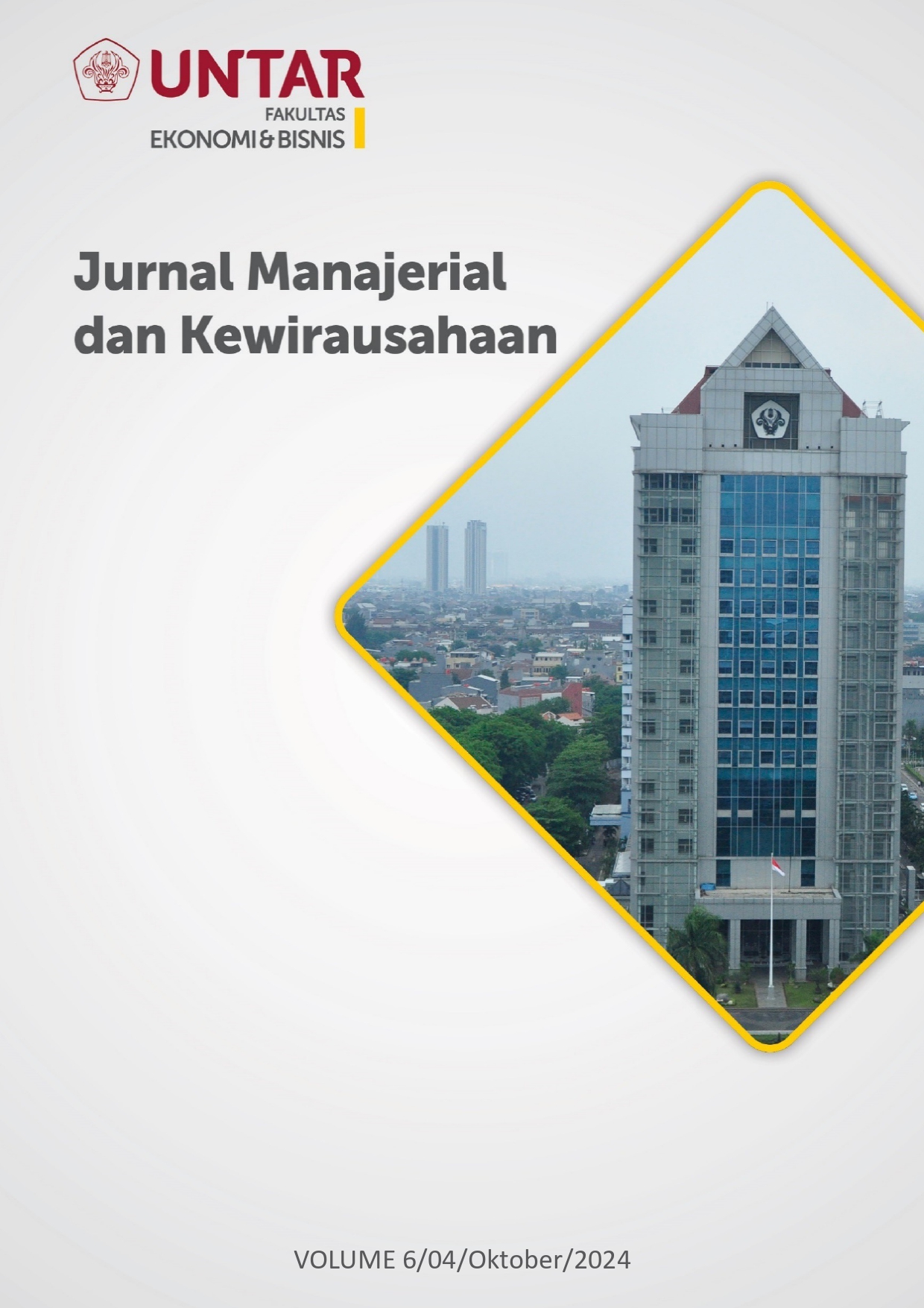Orientasi Pasar dan Keunggulan Produk Baru pada UKM Tekstil Jakarta
Main Article Content
Abstract
This research explores the impact of market orientation in textile Small and Medium Enterprises (SMEs) on new product advantages, as well as the moderating role of innovation capability. The findings show that Customer Orientation makes a significant positive contribution to New Product Excellence. Innovation Capability has a significant positive moderating impact, strengthening the relationship between Customer Orientation and New Product Advantage. Although Competitive Orientation has a significant negative impact on New Product Advantage, Innovation Capability has a positive moderating effect that optimizes its interrelationship. In addition, Inter-Functional Coordination has a significant positive impact on New Product Advantage, and Innovation Capability functions as a negative moderator that moderates the relationship between the two. The implication is that a holistic strategy that integrates customer orientation, innovation capabilities and inter-functional coordination is the key to achieving sustainable new product excellence in the context of textile SMEs.
Article Details

This work is licensed under a Creative Commons Attribution-NonCommercial-ShareAlike 4.0 International License.
This work is licensed under a Jurnal Muara Ilmu Ekonomi dan Bisnis Creative Commons Attribution-ShareAlike 4.0 International License.,/p>
References
Amanda, L., Yanuar, F., & Devianto, D. (2019). Uji Validitas dan Reliabilitas Tingkat Partisipasi Politik Masyarakat Kota Padang. Jurnal Matematika UNAND, 8(1), 179-188. https://doi.org/10.25077/jmu.8.1.179-188.2019
Chang, H. J., Huang, K. C., & Wu, C. H. (2006), Determination of Sample Size in Using Central Limit Theorem for Weibull Distribution. Information and Management Sciences, 17(3), 31-46.
Daniella, C. & Utama, L. (2023). Pengaruh Orientasi Kewirausahaan, Orientasi Pasar dan Inovasi terhadap Kinerja UMKM Bidang Fashion. Jurnal Manajerial dan Kewirausahaan, 5(4), 882-890. https://doi.org/10.24912/jmk.v5i4.26932
Diana Kolbe, Marta Frasquet, & Calderon (2021). The role of market orientation and innovation capability in export performance of small- and medium-sized enterprises: a Latin American perspective. Multinational Business Review Vol. 30 No. 2, 2022 pp. 289-312. https://doi.org/10.1108/MBR-10-2020-0202
Guo, C., Wang, Y. J., Hao, A. W., & Saran, A. (2018). Strategic positioning, timing of entry, and new product performance in business-to-business markets: do market-oriented firms make better decisions? Journal of Business-to-Business Marketing, 25(1), 51–64. https://doi.org/10.1080/1051712X.2018.1424690
Hamel, C. & Wijaya, A. (2020). Pengaruh Orientasi Kewirausahaan dan Orientasi Pasar terhadap Kinerja Usaha UKM Di Jakarta Barat. Jurnal Manajerial dan Kewirausahaan, 2(4), 863-872. https://doi.org/10.24912/jmk.v2i4.9865
Kumar, M., Talib, S. A., & Ramayah, T. (2013). Business Research Methods. Selangor, Malayisa: Oxford University Press.
Memon, M. A., Ting, H., Cheah, J.-H., Thurasamy, R., Chuah, F., & Huei Cham, T. (2020). g Sample Size for Survey Research: Review and Recommendations. In Journal of Applied Structural Equation Modeling (Vol. 4, Issue 2).
Merline, M. & Widjaja, O. H. (2022). Pengaruh Pengetahuan Kewirausahaan, Orientasi Kewirausahaan, dan Inovasi terhadap Keberhasilan UKM Alumni dan Mahasiswa Universitas Tarumanagara. Jurnal Manajerial dan Kewirausahaan, 4(2), 435-443. https://doi.org/10.24912/jmk.v4i2.18243
Ndiaye, N., Razak, L.A., Nagayev, R., Ng, A. Demystifying small and medium enterprises (SMEs) performance in emerging and developing economies. Borsa Istanb. Rev. 2018, 18, 269–281.
Nurcahyo, dan Khasanah.2016. “Analisis Pengaruh Persepsi Harga, Kualitas Pelayanan, Lokasi dan Word of Mouth Terhadap Keputusan Pembelian (Studi pada Taman Joglo Cafe Semarang)”. Diponogoro Journal of Management, Vol. 5 No. 3.
Obi, J., Ibidunni, A.S., Tolulope, A., Olokundun, M.A., Amaihian, A.B., Borishade, T.T., Fred, P. Contribution of small and medium enterprises to economic development: Evidence from a transiting economy. Data Brief 2018, 18, 835–839.
Organization for Economic Cooperation and Development – OECD (2019). Financing SMEs and Entrepreneurs 2019: An OECD Scoreboard. Available at: http:// www.oecd.org/cfe/smes/Policy-Highlights-Scoreboard2019-Final-opt.pdf (accessed on 12 May 2019).
Organization for Economic Cooperation and Development – OECD (2017). Meeting of the OECD Council at Ministerial Level: Enhancing the Contributions of SMEs in a Global and Digitalised Economy. Available at: https://www.oecd.org/mcm/documents/C-MIN-2017-8-EN.pdf (accessed 12 May 2019).
Pantouvakis, A., Vlachos, I, & PD Zervopoulos (2017). Market orientation for sustainable performance and the inverted-U moderation of firm size: Evidence from the Greek shipping industry. Journal of Cleaner Production, 165, 705–720 https://doi.org/10.1016/j.jclepro.2017.07.135
Prasetyo, A. & Wijaya, A. (2019). Pengaruh Orientasi Kewirausahaan dan Orientasi Pasar terhadap Kinerja UMKM pada Bidang Kuliner di Pasar Lama Tangerang. Jurnal Manajerial dan Kewirausahaan, 1(3), 383-393. https://doi.org/10.24912/jmk.v1i3.5329
Suki, N. M., & Suki, N. M. (2017). Determining students’ behavioural intention to use animation and storytelling applying the UTAUT model: The moderating roles of gender and experience level. International Journal of Management Education, 15(3), 528–538. https://doi.org/10.1016/j.ijme.2017.10.002
Sultana, J. (2020). Determining the factors that affect the uses of Mobile Cloud Learning (MCL) platform Blackboard- a modification of the UTAUT model. Education and Information Technologies, 25(1), 223–238. https://doi.org/10.1007/s10639-019-09969-1
Sekaran, U., & Bougie, R. (2016). Research Methods for Business: A Skill Building Approach (7th ed.). United Kingdom: John Wiley & Sons Ltd.
Yusuf, A. & Soelaiman, L. (2022). Pengaruh Keterampilan, Orientasi Pasar dan Jaringan Usaha terhadap Kinerja UMKM melalui Kompetensi Wirausaha. Jurnal Manajerial Dan Kewirausahaan, 4(1), 22-30. https://doi.org/10.24912/jmk.v4i1.17120



